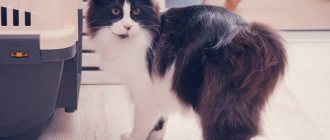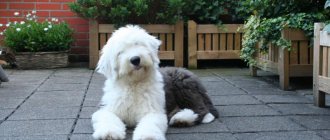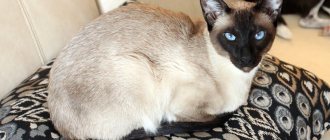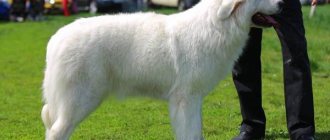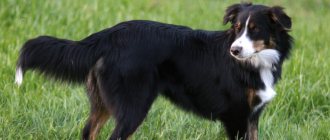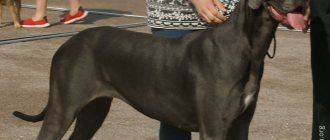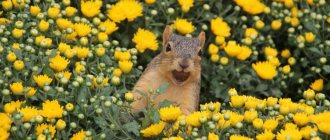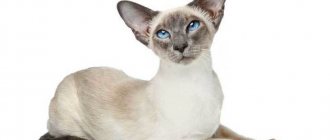There are hundreds and thousands of different cat breeds in the world, some have thick fur, some have long ears, others have no fur at all.
Such diversity leads to the fact that people are completely lost in the abyss of ignorance in matters of proper care and nutrition for both small kittens and adult cats. The topic of our article today will concern the preparation of the correct diet for kittens of the Kuril Bobtail breed.
Kurilian Bobtail - features of the breed
Having studied the characteristics of the breed, you can adjust your pet’s diet according to its needs. In many cases, a properly formulated diet serves to prevent diseases to which the kitten is genetically prone.
There are at least two hereditary diseases of the Kuril Bobtail, the risk of which directly depends on the diet:
- Fissures, inflammation of the anus, thrombosis of hemorrhoidal veins (hemorrhoids) - problems can be either hereditary or acquired due to poor nutrition. Prevention of diseases is constant monitoring of bowel movements and a diet that prevents the development of constipation.
- Urolithiasis of the acid or acid-base type - due to the breed characteristics and origin, Kuril Bobtails are distinguished by the acidic pH of their urine. Standard food for the prevention of urolithiasis is contraindicated for the breed. If there is a risk of sand and stone formation, therapy should only be prescribed by a veterinarian.
Kurilian Bobtails are healthy, physically strong cats with a “vigorous” and aggressive immune system. However, basic vaccination for representatives of the breed is mandatory!
The breed was formed under severe climatic pressure and the risks of island life. Bobtails have no resistance to mainland, common deadly viruses!
Sample menu by age
By creating a sample menu by age for a Kurilian Bobtail kitten, you can calculate the potential physical and financial costs. It is important to understand that in the first year of life, it is extremely undesirable to change the type of diet of the ward.
Note! A sudden change in diet is justified only if the kitten is fed economy class food or an unbalanced, natural diet.
Up to a month
Up to a month, kittens feed only on mother's milk. If a kitten is deprived of maternal care, it must be artificially fed.
Natural menu for a kitten up to a month old:
- Goat milk diluted with boiled water.
- Scott's kitten mix.
- Tiling mix for kittens.
- Cat milk replacer.
- From 1.5–2 weeks – infant formula “from 0” (without additives and sugar).
The daily food intake ranges from 30 to 40 ml, depending on the number of babies in the litter, individual characteristics and dimensions.
Number of feedings for a kitten under one month of age:
- From birth to 2 weeks, kittens eat every 2 hours. In total, about 10 times a day.
- From 2 to 4 weeks, kittens eat every 2–3 hours, with a night break lasting 4–6 hours. A total of approximately 8 times a day.
Important! In addition to regular feeding, the survival of kittens depends on maintaining an acceptable temperature in the nest and care (maintaining cleanliness, massaging their tummies, regular inspection).
1 month
At 1 month, kittens begin to open their eyes and leave the nest. Contrary to popular myths, tailless kittens do not suffer from balance problems and learn to walk at a normal pace.
- Mother's milk.
- Whole goat or cow's milk.
- Low-fat beef broth.
- Boiled minced meat mixed with broth and homemade meat pate.
- Cat milk replacer or infant formula.
- In case of growth retardation - pate for emaciated kittens.
The serving size depends on the rate of formation, development and weight gain. The daily food intake ranges from 60–80 grams.
Number of feedings: 6–7 times a day, excluding mother’s milk.
2 months
At 2 months, babies begin to grow at an alarming rate and consume supplementary food much more actively. Most breeders note that two-month-old kittens eat more often than they should according to the standard schedule.
- Mother's milk or natural substitute.
- Whole cow's or goat's milk.
- Calcined cottage cheese.
- Dairy products.
- Bouillon.
- Boiled minced meat (carefully chopped).
- Chopped, raw, boiled or pre-frozen meat (beef).
- Cat milk replacer or infant formula.
- Canned food for kittens.
The daily food intake directly depends on body weight and ranges from 60–90 grams. The number of feedings varies from 5 to 8 times a day, excluding mother's milk consumed.
3 months
At 3 months, kittens’ appetite and frequency of food intake stabilizes. Babies continue to grow actively, and their bodies begin to prepare for changing teeth, which leads to an increase in the need for microelements.
Immediately after worming and vaccination, the kitten may lose weight a little - this is normal.
- Mother's milk or its substitute.
- Whole milk, fermented milk products, calcined cottage cheese.
- Boiled minced meat, raw, chopped meat.
- The broth is low-fat, pure or with egg.
- Raw quail eggs or chicken egg yolk. Can be mixed with cottage cheese.
- Raw grated carrots, a little green apple.
- Cat milk replacer or infant formula.
- Canned food for kittens.
- Semi-moist food for kittens.
Drinking regime
Regardless of the type of food - industrial or natural, it is important to maintain a drinking regime. The kitten's water needs to be changed every day. The Kurilian Bobtail drinks less than 250 ml of water per day. It is especially important to ensure sufficient water intake if your pet eats only dry products.
If a kitten drinks little water, you should find out the reasons for this phenomenon. Your baby may not like the bowl of liquid or the quality of the water. Insufficient fluid intake can lead to the development of a number of diseases of the digestive and urinary system in an adult cat.
Vitamins and minerals
The advantage of using ready-made commercial diets is that they already contain the necessary vitamins and minerals. There is no need to give them separately to your pet. But if a kitten eats natural products, it must additionally receive useful minerals. Recommended vitamins for Kurilian Bobtail kittens:
- Veda from Biorhythm, Russia . The vitamin complex is approved for kittens from the age of 2 months. Number of vitamins per day – 2 pcs. The package contains 2 types of tablets - morning and evening. The morning tablet contains substances that have a positive effect on the digestive and nervous systems and immunity. The composition of the tablet for evening use is substances intended to care for the animal’s fur: beauty and active growth. The course of taking the vitamin complex is 24 days. If necessary, the course is repeated after 7 days.
- Jimket, made in Germany . The package contains pink and green vitamins. Pink tablets contain fruit extracts, green tablets contain seaweed. The general composition of the complex includes all the substances necessary for a kitten. These are vitamins A, E, group B, K. Minerals: calcium, L-carnitine, taurine. Also contains nicotinic acid.
- Beafar, made in the Netherlands . The tablets have a pleasant smell that kittens really like. The composition is represented by vitamins PP, H and B. The complex is approved for use by animals aged 6 weeks and older. Vitamin dosage – 8 pcs. for every kg of body weight.
- Farmavit Active, Russia. The composition is represented by useful substances: vitamins A, B, E, H, mineral elements: phosphorus, calcium, taurine, rutin. The vitamin complex is useful because it helps improve digestion and replenishes the lack of nutrients in the gastrointestinal tract. The course of taking the complex is 30 days, after which you need to take a break of 6 to 8 weeks. Dosage – kittens under 3 months of age – ½ tablet, after 3 months – 1 tablet. per day.
Kittens that eat ready-made food should be given vitamins if they have health or coat problems.
Choosing a place and dishes for feeding a kitten
The choice of place and utensils for feeding plays an important role, at least in the first days of life in a new home. Until the kitten has adapted, you need to make sure that while eating, he feels comfortable and safe.
If you have other pets in your home, feed the newbie separately.
When choosing bowls, you need to consider the following factors:
- The material from which the bowls are made.
- Width (bowl diameter).
- Depth.
According to the experience of the owners, it is better to purchase bowls made of stainless steel or ceramics. When eating, the cat's whiskers should not rest against the sides, so the diameter of the bowl should be 1.5–2 times larger than the diameter of the muzzle. The depth of the bowl depends on the purpose. Almost flat bowls are needed for food, and deep ones for water.
Recommendations for organizing a place for eating
The dishes from which the newly purchased small bobtail will be fed must be of high quality and stable, have good capacity and high sides. Number of bowls – 2. One container is used for food, the second – water.
Materials for making dishes for kittens:
- Ceramics . The only drawback of ceramic bowls is their fragility. Kurilian Bobtails are lively and active kittens. They may play with the food bowl, pushing it away with their paw, causing it to break. Therefore, you need to choose a ceramic bowl with thick walls; it will have more weight, which will prevent it from rolling all over the floor. The advantage of using ceramics is high quality; such material will not impart an extraneous taste to food and water.
- Metal utensils are durable, reliable, and cannot be damaged, much less broken, by the paws of a moving kitten. In addition, stainless steel bowls are easy to clean.
- Plastic – the advantage of plastic bowls is their low cost. For kittens, it is recommended to choose plastic bowls with a special stand that will protect the floor from scattered food.
The depth of the dish depends on the type of food. If the kitten eats industrial food, you need to choose deep bowls with high sides for it. It is better to place natural products or liquid canned food in a shallow bowl.
Where is the best place to place the bowls? In the shared kitchen. Kurilian Bobtails are a very sociable breed of cats, and they will prefer to eat food with members of their household. You need to choose a place to place the bowls once and for all. It is not recommended to move the dishes further.
Caring for dishes. Of course, bowls should be washed regularly. However, you cannot use detergents for this. It is enough to treat them with hot water and a soft sponge.
Bowls should be washed daily.
Cat food
Eating dry pads and fresh meat or fish at the same meal will provoke pathologies of the gastrointestinal tract.
Only the highest quality food is suitable for the hunting breed - Royal Canin, Orijen, Pro Plan or Hill's. You can buy dry rations or wet canned food, but such meals should not be frequent. Nutritious dry mixtures from the economic line are strictly prohibited, as they can lead to allergies, pathology of the gastrointestinal tract and kidney failure. Whiskas and Kitty Kats are especially dangerous.
Overeating is dangerous for bobtails
The importance of nutrition for the proper development and formation of the skeleton and muscles cannot be exaggerated. For the first two days after purchasing a puppy, it should be fed in the same way as the breeders fed the puppies. Therefore, you should ask them for details at what time and how they fed the puppies. Introduce new foods gradually and little by little (not all at once in one day). Puppies should be fed often, but in small portions. Then the puppy does not overfeed and, therefore, the additional weight of an overfilled stomach does not put pressure on the fragile legs.
Overeating is a more common cause of weak metatarsus than hereditary weakness. The puppy should constantly gain weight, but not due to the build-up of fat, but due to muscle tissue. Therefore, the main diet of a growing puppy is protein: meat, cottage cheese, (later) fish.
What to feed a Kuril Bobtail kitten - choosing the type of diet
When deciding what to feed your Kuril Bobtail kitten, you need to choose from three basic options:
- Natural feeding.
- Industrial feeding.
- Mixed feeding.
Each type of feeding has pros and cons, which we will discuss below. When deciding on a diet, you need to take into account the needs of your pet. Please note in advance that keeping a purebred cat (as well as a mongrel cat) is not cheap, so in addition to physical costs, you need to take into account potential financial costs.
Natural diet
A natural diet for a Kuril Bobtail kitten includes:
- Feeding raw and cooked foods in pure and mixed form.
- Feeding exclusively raw foods is a raw food diet.
- Feeding with homemade semi-finished products.
Advantages:
- Product quality and freshness control.
- Cheaper than food of similar quality.
- The ability to adjust the caloric content of the diet according to the seasons and needs.
Flaws:
- Time-consuming – food for your pet needs to be prepared separately and regularly.
- The need to include missing vitamins and microelements in the diet.
- Difficulties in calculating the nutritional value of the diet.
The advantage of a natural diet is its naturalness. A Kurilian Bobtail kitten can be switched to natural food from the age of one month. If the baby has a normal microflora, there will be no digestive problems with natural supplementary feeding.
Ready-made feed
Ready-made feeds are divided into types:
- Dry – granules.
- Semi-moist - pieces with gravy or jelly.
- Wet - pate or paste.
- Treats.
Veterinarians and manufacturers of industrial food for animals recommend alternating types of food. When kept on exclusively dry food, there is a risk of rapid deterioration of tooth enamel.
If a cat eats only soft food, the load on the gums is reduced, and this is fraught with inflammation and various diseases of the oral cavity.
Based on quality, finished feed is divided into classes:
- Economy
- Premium
- Super premium.
- Holistic.
Economy feeds are not suitable for everyday feeding of animals.
If the kitten is healthy, premium or higher daily food will suit him. If the pet has chronic health problems, it (on the recommendation of a veterinarian) is transferred to food from specialized lines:
- Supportive.
- Preventive.
- Medicinal.
- For exhausted kittens and adult animals.
Advantages of ready-made feed:
- No need to cook - saves time.
- It is easy to store and calculate the duck food allowance.
- High-quality feed contains all the necessary vitamins and minerals
Disadvantages of ready-made feeds:
- Good food is much more expensive than natural food.
- The food may not be suitable for your pet.
- Premium food contains a lot of carbohydrates, and this can lead to excess weight gain.
A Kurilian Bobtail kitten can be fed ready-made, wet food from the age of one month. A kitten can be switched to dry food only after changing its teeth.
Mixed diet
Mixed diet – simultaneous feeding of the pet with natural and industrial food. A mixed diet does not create visible problems while the kitten is young. However, feeding different types of food always leads to dysbiosis. Dysbacteriosis is one of the reasons for the development of chronic digestive problems: diarrhea, constipation, indigestion.
Be that as it may, even if circumstances force you to have a mixed diet, it is important to understand that a Kurilian Bobtail kitten will not be able to digest food of different textures until 4–5 months of age.
Advice! If for some reason you feed your pet natural and industrial products, separate them and feed them at different meals. In this case, it is better to soak dry food.
Features of diet preparation
Each owner needs to immediately decide what to feed their pet and accustom it from childhood to a certain type of food, so that later they do not have to change it.
Types of diets:
- Ready-made industrial feed . This is store-bought dry food or canned food. This type of food is as convenient as possible for the owners. The advantage of industrial feeds is that they have the most balanced composition, rich in vitamins and minerals.
- Natural nutrition is considered to be as close as possible to the natural diet of animals . The advantage of natural products is their variety of taste and the presence in them of a sufficient amount of substances beneficial to the animal. The disadvantage of natural food is that owners need to “tinker” with it, while every day preparing new dishes for their pet, subjecting the food to heat treatments.
- Mixed – alternation of industrial feeds and natural products.
Features of feeding bobtails. Veterinarians and breeders do not recommend keeping the Kurilian Bobtail on a mixed diet. The combination of different types of foods often leads to digestive disorders in children. The reason for this is an imbalance of carbohydrates, proteins and fats.
Creating a correct, balanced menu for Kuril Bobtail kittens is not an easy task. Despite their friendly disposition, representatives of the breed are particularly picky about their diet. If the kitten does not initially like the product, he will never eat it, no matter how useful and necessary it may be.
Transferring a bobtail baby from one type of food to another. When buying a kitten from your own hands or from breeders, you should find out what kind of food it was on. If you want to switch your baby from industrial food to natural products or vice versa, it is recommended to do this immediately, while the pet is still small. It is best to switch from one type of food to another according to the recommendations of a veterinarian.
Origin story
How exactly the Kuril Bobtail breed appeared is still unknown. These cats first appeared on the Kuril Islands (hence the name) as a result of natural crossing of Japanese bobtails and Russian Siberian cats, which were brought to the islands by Russian merchants and fishermen. These agile animals with pom-pom tails have adapted well to the harsh climate: they have learned to excel at catching fish and rodents. Sometimes unusual cats were brought to the “mainland” as living souvenirs, but they became seriously interested in the breed only in the late 80s of the twentieth century.
Initially, felinologists did not distinguish between Japanese and Kuril bobtails, but later they noticed that the body structure, head shape and coat were significantly different from their Japanese relatives. In 1991, Moscow breeder Olga Mironova developed a breed standard, which was approved by the Soviet Feline Federation. And in 1994, the new breed was officially the world's specialists. Now there are more than a hundred Kuril Bobtail nurseries all over the world: loyal cats with an unusual appearance quickly won the love and respect of their owners.
Vitamins and supplements in a kitten's diet
If you feed your kitten natural products, you need to introduce vitamins and supplements into the diet. Natural vitamin supplements for:
- Meat and bone meal.
- Fish, chicken, beef liver.
- Greens, vegetables, fruits.
- Sunflower oil, olive oil.
- Brewer's yeast.
- Soft, boiled cartilage.
Pharmacy vitamin supplements:
- Fish fat.
- Feed tricalcium phosphate.
- Omega-3, Omega-6.
- B vitamins.
In addition to vitamins and microelements, the kitten should receive taurine, which is found in the following products:
- Turkey.
- Rabbit.
- Chicken heart, liver.
- Beef heart.
- Pork, ham, trimmed of fat, after deep freezing.
- Pork liver, heat-treated.
- Ocean fish, shellfish.
- Raw red fish.
- Homemade live yogurt.
- Whole milk.
To make their lives easier, many owners give their pets industrial vitamin complexes. The drugs can be purchased at a veterinary pharmacy or pet store. Industrial vitamins help support metabolism and prevent dental diseases.
Bobtail care
Caring for a Kuril breed cat includes a standard set of hygiene procedures, regardless of the length of the coat and other individual characteristics. The only difference: a short-haired cat creates fewer problems during shedding.
- The owner of a purebred animal must periodically inspect the ears. To remove dirt, use a regular cotton pad and a special lotion (you can buy it at a pet store), which allows you to carefully clean the ears of wax, and at the same time carry out effective disinfection.
- No special care is required for the eyes; a smart cat copes with this hygiene procedure on its own. If brownish accumulations are detected in the corner of the eyes, you can carefully clean them with cotton wool dipped in warm tea without brewing or in a special solution.
- To trim overgrown claws, a nail cutter is a practical tool for creating a beautiful manicure for cats.
- It is not necessary to bathe your pet often; 1-2 bath procedures per month are enough. To thoroughly clean thick fur, you can use a special cat shampoo. After washing, the animal is dried with a towel. Next, you need to comb out the shedding undercoat. After the bath, the cat looks a little unusual. His fur becomes unnaturally fluffy, but after 2-3 days the usual appearance will be restored.
To eliminate fleas and reduce the risk of infection with helminths and ticks during street walks, you can use pharmaceutical products for animals. Every pet store has effective medications designed for the age and weight of the animal.
Meat delicacies
Adding meat products to your diet should be approached responsibly.
There are a number of “holy” truths that should be followed for the proper growth and development of the baby:
- Meat and fish products can only be given boiled.
- The serving should be small pieces, preferably in the form of minced meat.
- Under no circumstances should you give meat every day. Alternate foods.
- It is better to completely exclude pork from the menu, as well as liver and giblets.
- Chicken and turkey liver are allowed in limited quantities.
Diet from natural products
Owners of growing small bobtails should understand one simple rule - feeding the kitten food from the common table is strictly prohibited. It is important to correctly and carefully select products for your pet so that they are healthy and of high quality. A natural diet may include:
- By-products – liver and kidneys. The liver has a positive effect on the digestive process, especially intestinal peristalsis. If your kitten is constipated, a piece of raw liver will help. Diarrhea can be eliminated with liver that has previously undergone heat treatment. The product can be boiled, baked or stewed. The kidneys must be soaked in cold water or scalded with boiling water. Heart – served to the kitten raw. Kurilian bobtail kittens are very fond of chicken, small hearts that do not need to be chopped with a knife.
- Dairy products : kefir, fermented baked milk, cottage cheese. Kids love to devour sour cream and cream, but the fat content of the products should not exceed 15%.
- Fish – mainly sea fish, frozen, served boiled or scalded with boiling water.
- Sources of fat are olive oil, add small amounts to other dishes. It is recommended to give your pet chicken or quail eggs from time to time.
- Cereals – buckwheat, oatmeal and rice. The volume of cereals per day is no more than 20% of the total amount of food.
- Vegetables – cauliflower and carrots.
- Fruits are provided upon request. You can do without them.
Each product, especially offal, has its own age restrictions. This must be taken into account when creating a menu for a small pet.
Prohibited natural products
A kitten's diet should not contain:
- sweets, confectionery, chocolate;
- alcoholic and alcohol-containing products;
- some fruits - avocado, raisins, dried apricots, grapes;
- vegetables - garlic, legumes, tomatoes, potatoes;
- milk;
- spices;
- salts – strictly in limited quantities;
- baking, bakery products.
These products have an extremely negative effect on the condition of the kitten’s digestive system, causing stool problems and a number of diseases in adulthood.
Recommendations for natural nutrition
Natural products should be given to kittens carefully, observing age restrictions, food consistency and frequency of consumption of certain products:
- Porridge. For very small kittens, cereals can be boiled in milk, necessarily diluted with water (in equal proportions). It is not allowed to add any seasonings to porridge. The first porridges as complementary foods should be very liquid. As your pet develops and is able to eat more solid food, the porridge is gradually made thicker.
- Complementary feeding with fermented milk products begins with baby cottage cheese with a high calcium content. You can prepare the product yourself - bring the milk to a boil, add 1 tsp to it. calcium chloride. When flakes appear on the surface of the milk, the product is filtered.
- Fruits are optional, but vegetables should be on the menu regularly. Apple, cabbage or carrots are grated and can be seasoned with a small amount of vegetable oil, preferably olive oil.
Features of preparing and serving meat products. Meat, as a source of protein, should be the basis of the diet. But it is impossible to give it to a kitten thoughtlessly and in large quantities. In order not to harm your pet’s digestive system, you should adhere to a number of recommendations:
- The meat must be boiled first.
- Serving method: cut into small pieces, but it is preferable to give minced meat to kittens.
- Meat should not be the only product that your baby eats every day. Meat dishes must be alternated with others. It is not recommended to give your kitten meat every day, so as not to overload the digestive system.
- It is forbidden to give pork to kittens. The exception is pork offal with liver. But such a dish should be present in a pet’s diet extremely rarely.
- Turkey or chicken liver is allowed, but rare.
Following all the recommendations will help you create a correct, varied and balanced diet for your pet.
Yummy
It’s not hard to guess that tasty things in our and cat’s understanding are very different things. For a cat, a treat can be a piece of delicious fish, fresh beef without veins, or, for example, a little of your favorite dry food. Of course, each owner decides for himself how and when to pamper his cat with treats.
We can only remind you that it is better to do this infrequently, not every day, and, of course, you should not feed your cat delicacies, much less sweets or cookies. Cats are capricious creatures; if they get used to treats, they can sabotage ordinary food and skillfully pretend that they are dying of hunger (Fig. 8).
Rice. 8. Kittens with an apple (Maxwell and Maggie)
Prohibited Products
It is important to exclude prohibited foods from the Kuril Bobtail kitten’s diet:
- Bones, pure fat, skin, especially poultry.
- Palm oil.
- Grapes, raisins.
- Juicy and sweet fruits.
- Soy.
- Mushrooms.
- Corn and semolina.
- Raw freshwater fish.
- Dry, salted fish.
- Products containing sugar or its substitutes, xylitol (chewing gum, some sweets), flour or yeast, caffeine, cocoa, any stimulants (sweets, tea, coffee, chocolate), marinades, salt, spices.
- Smoked products, including sausages, balyki, fish.
- Expired products.
- Leftovers from the table.
Controversial foods in the diet of a Kuril Bobtail kitten are:
- Fresh pork is a source of helminths and false rabies.
- Raw ocean fish are a source of helminths.
- Whole milk – risk of individual intolerance.
- Chicken eggs are an allergen.
- Factory-bred chicken – risk of allergies and individual intolerances.
- Raw and boiled chicken liver in large quantities.
- Cereals.
Almost all controversial products are beneficial for your pet, but when introducing them into the diet you need to act wisely . Products that can become sources of parasites must first be boiled or frozen for 4–5 days. Products to which a kitten may be allergic should be introduced into the diet in small quantities, monitoring the body's reaction.
Feeding with industrial feed
Ready-made food is the most popular type of food. This is convenient for the owners, as well as tasty and very healthy for the mustachios. To maintain the health of the Kuril Bobtail at the proper level, you need to choose expensive, high-quality commercial diets:
- Holistics - this type of industrial food for cats is the most expensive, but also the highest quality. Dry food of this class contains all the necessary vitamins and mineral elements in proportions that correspond to age and physiological standards. In addition to meat and cereals, the food contains probiotics, which have a positive effect on digestion processes. Recommended types of holistic treatments: Grandorf, Farmina.
- Super-premium food - a little lower in quality than holistic food, but a very good product that can be safely given to a Kuril Bobtail kitten. As a source of protein, these foods contain dried meat, vegetables, and sources of carbohydrates - wheat and rice. The food also contains dried fruits and berries. Recommended foods for Kurilian Bobtails are Fitmin, Savarra, Brit Care.
- Premium – the quality and cost of this category of feed is lower than that of the super-premium class. The product is healthy, tasty, and contains a balanced amount of vitamins and minerals. For a bobtail kitten, it is recommended to choose our brand, Sheba, Brit Premium.
Low-quality products are prohibited. Economy class feed is the lowest in quality. The main ingredient is corn, sometimes wheat. The source of protein is offal. Such products are not recommended for Kuril Bobtail babies. Otherwise, problems are possible not only with the digestive tract, but also with hair, vision, skin, etc.
External standard
According to the accepted external standard, bobtails from the Kuril Islands must have the following characteristics:
The head is large with a wedge-shaped muzzle, narrowed at the bottom.
The eyes are medium in size, the upper part of the eye is oval, the lower part is rounded. Located from each other at a distance equal to the size of one eye. The color depends on the coat color; different colored eyes are possible.
The ears are medium in size, triangular in shape, ending in a slight curve. They have a distinctive feature - a slight forward tilt angle. Tassels are allowed on the ears.
The nose is medium in size, quite wide, straight in shape.
The bones and muscles are powerful and well developed.
The paws are rounded towards the bottom.
The coat can be presented in several options:
Short hair over the entire surface of the body with a medium-developed undercoat. It is soft, velvety to the touch, resembling the fur of exotic cats or British cats.
Semi-long coat with medium undercoat, forms fluffy pants, collar and socks. With this option, the tail should be very fluffy.
The tail might look like this:
Panicle. The tail consists of several vertebrae, according to the standard from 5 to 13, has creases and reaches a length of less than 14 cm.
Stump. A shortened tail of 2–8 motionlessly fused vertebrae reaches a length of approximately 5 cm.
Spiral. It is considered the most luxurious tail option. It is twisted in the form of a ring and can have a fairly decent length. The number of vertebrae ranges from 5 to 10.
The external standard must be strictly observed in the case of registration of a pedigree or participation in an exhibition.
Types of bobtail breed:
- American - a large cat with long or short hair;
- Thai - with excellent almond-shaped eyes of a rich blue color;
- Japanese - a graceful animal with a clearly athletic build;
- the Karelian cat has longer hair on the tail;
- The Kurilian representative (breed description below) is an affectionate, friendly and very cute cat with an amazing character and loyalty.
Domestic cats of natural origin - bobtail, have ancestors from the Kuril Islands, Kamchatka and Sakhalin. They have well-developed bones, the length of the coat is semi-long or short, and the tail is of unusually short length.
Character
The most pronounced features of the Kuril Bobtail
– this is attachment to people and a complete absence of aggression. These big bumpkins still retain their passion for fishing. They love water and find it everywhere. A bobtail is always not averse to a swim, and it can swim as well as a dog. By the way, bobtails are constantly compared to dogs; their behavior has too much in common.
In describing the character
of the Kurilian Bobtail,
one can often find mention of their constant need for communication. They can follow their owner for days, waiting to finally play with him. Usually cats of this breed choose one person in the family as the main one, but they will never offend other members either. Bobtails are especially tolerant of children, allowing them to do almost anything.
Another point in describing
the character of the Kuril Bobtail
breed is that bobtails master the entire household routine and way of life with incredible ease. They quickly get used to the designated area and litter tray. The only thing they need is a spacious room, as they love to jump and play.
Colors
Today, the recognized colors
of the Kuril Bobtail
are the following options:
- Red
- Cream
- Blue
- Black
- Tortoiseshell
- White
- Tortoise blue cream
If there is a white undercoat, the color is called silver or smoke, while the peach version is called amber or gold. Golden Kuril Bobtails look especially luxurious
This breed is allowed to have agouti color and various tabby patterns - marbled and spotted. The only option not recognized by the standard is color point. The black Kurilian bobtail has become popular recently
thanks to its unusually chic appearance.
Cat's temperament
Experts call this breed wonderful in every way. The Kurilian Bobtail is kind and friendly to all family members, loves affection and active games, is smart and inquisitive. But, cat owners note that with all the advantages in character, there are also disadvantages: they love independence and willfulness.
“Kuriles” are very careful creatures, they rarely go into the arms of strangers, it is necessary to find a special approach to the animal so that it “allows” to be friends with itself. Bobtails prefer to independently choose whom to be friends with and whom to avoid.
Cats from the Kuril Islands are sociable creatures that require constant attention from fidgets. Not everyone can withstand their energy, so if you like cats that are less persistent in communication, choose a breed with a calmer temperament.
The creatures have a sharp mind, are extremely inquisitive, and quickly adopt the skills of other animals living nearby. Experts believe that Kuril Bobtails are easy to train and can be easily taught funny tricks (it is especially easy to teach something if the training takes place in a playful way). This breed of cats, almost like dogs, are capable of bringing toys or a small ball thrown by a child. Especially favorite games are “hide and seek”, “catch” and “catch up”.
Contents in the apartment
Unfortunately, living in an apartment, this breed of “lynx” cannot express itself to its full potential. But once in nature, this cat is able to show all its talents. They love to hunt and fish, and do not feel afraid of water, forests or darkness. Be 100% sure that once in a familiar habitat, bobtails will show themselves in all their glory, and you will learn a lot of new, fun and good things about your pet.
In “apartment” life, this breed behaves peacefully and sociably. She is able to make friends with other inhabitants (if there are any). But the optimal communication for them is their brothers from the Kuril Islands and people. The following situation often occurs: a person got himself one bobtail, fell in love with him with all his soul for his affectionate and kind character, and then got several more individuals “for company.”
It is also necessary to remember that the “Kurilians” do not perfectly agree with all representatives of the animal world. Possessing the instinct of a hunter, these cats are not welcome in the proximity of hamsters or parrots - they will easily become the prey of a real hunter.
The originality of the Kurils is off the charts; they always want to live exclusively by their own rules. For this reason, experts recommend teaching cats to be orderly from the first days. Otherwise, there is a risk of becoming completely dependent on this animal, which imagines itself to be the rightful owner in the house.
It is quite problematic to retrain an adult with an already formed character. This will require a lot of effort and time; he almost never gives up the positions he has gained. If a cat sees that the situation is not to his taste, he begins to take revenge - this can manifest itself in different ways. Marking shoes and corners in the house, hanging on curtains and spilling food - this is not the whole list of “dirty tricks” that a bobtail can do.
If an animal is raised correctly, with affection and respect, problems will never arise.
